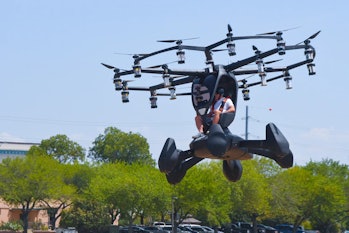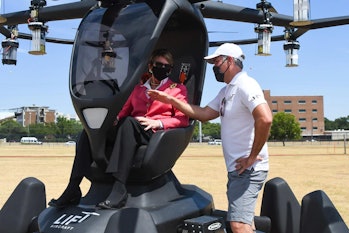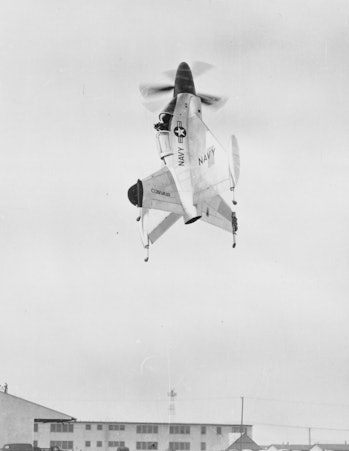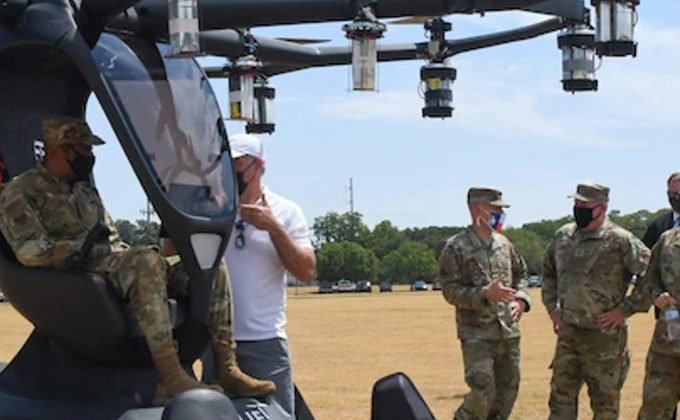New photos show the Air Force’s hunt for a flying car is getting weird
The Hexa, designed by a Texas company, was snapped flying for military leaders as part of a US government-sponsored competition.
ELECTRIC TAKE-OFF AND LANDING VEHICLES, also known as eVTOL, are futuristic travel options that could improve traffic from cities to suburbs. But the Air Force is bringing back military eVTOLs with a new program, Agility Prime.
And it just showed off its first prototype.
The vehicle, known as the Hexa, was built by Texas-based LIFT Aircraft. It is made entirely out of carbon fiber. LIFT’s website notes that the craft, which has eighteen rotors, weighs 432 pounds. A single vehicle costs $495,000.
And the website helpfully notes that “no pilot’s license is required to fly.”
The partnership between the company and the military was first announced in April. Recently, the company’s CEO, Matthew Chasen, piloted the Hexa while Secretary of the Air Force Barbara Barrett, Air Force Chief of Staff Gen. Charles Q. Brown, Jr., and Chief Master Sgt. of the Air Force JoAnne S. Bass watched on at Camp Mabry, a military installation in Austin, Texas.

Some modifications have been made to the Hexa as it appears in promotional material. On LIFT’s website, the landing equipment for the vehicle consists of four perimeter floats which allow for buoyancy and water landings. But in the hands of AFWERX, the Air Force’s experimental wing, the Hexa’s bottom has spurted six bollard-like legs.
Chasen tells Inverse that the company’s “first full-scale prototype has four airfoil-shaped legs with forward-facing, horizontal floats on each in addition to the center float. However, we changed the design to provide for more stability, redundancy and lower downwash drag.”
Speaking in April, Secretary Barrett acknowledged that some of the designs that come out of the Agility Prime initiative may appear unconventional.
“The thought of an electric vertical take-off and landing vehicle — a flying car — might seem straight out of a Hollywood movie, but by partnering today with stakeholders across industries and agencies, we can set up the United States for this aerospace phenomenon,” she said.

Before you imagine a fleet of Hexas flying into combat while “Danger Zone” blares, it’s unclear whether the Air Force is testing out this technology for military use. Agility Prime’s website defines the initiative as “a non-traditional program seeking to accelerate the commercial market for advanced air mobility vehicles.”
The Hexa test flight was the first step on what Agility Prime highlights as a priority: a “Race to Certification,” which would “drive government procurement of operational capability by 2023.” That means there’s a chance the government could offer a contract to participants in 2023.
A MILITARY HISTORY
If a form of the Hexa found itself on the battlefield, it wouldn’t exactly be a surprise.
VTOL flight has its history in military and government applications: its earliest iteration came from Nazi Germany, which developed a concept known as the Bachem Ba 349 B-1 Natter with the hopes of attacking Allied bombers without the need for space and time-consuming runways, which also provided planes with easy targets.

The technology wasn’t complete by the war’s end, but maybe that’s no bad thing. Experts at the Smithsonian say the plane “was a bad idea from the start and as a bomber interceptor, it was a total failure.”
Americans captured a Bachem Natter in the war’s waning days and shipped it back to America for study.
Using Nazi designs, the Allies began to experiment with the technology, developing vehicles like the Convair Pogo and Rolls Royce Thrust-Measuring Rig, also known as the “Flying Bedstead.” The technology was more closely associated with colorful failures until the development of the Harrier Jump Jet in 1967, which finally proved the usability of the technology.

Today, civilian companies race to prove the viability of VTOL craft for flying through urban cities and into suburbs as a means of traffic reduction. The American government has tried to be amenable to the technology — the Federal Aviation Authority is involved with at least 15 different eVTOL projects.
And with 15 companies signed on for Agility Prime, that connection will only deepen. But beyond tests, the commercial — and military — technology remains unproven.
Original story published HERE.
CLICK HERE to learn more about MIT Innovation Initiative’s Mission Innovation Program.

